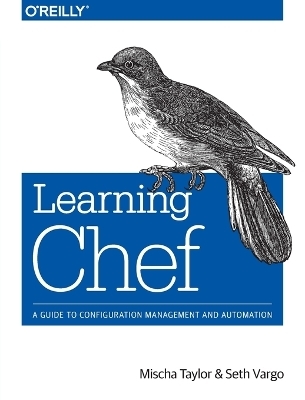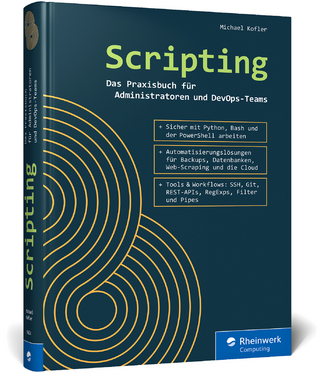
Learning Chef
O'Reilly Media (Verlag)
978-1-4919-4493-6 (ISBN)
After teaching you how to write Ruby-based Chef code, this book walks you through different Chef tools and configuration management concepts in each chapter, using detailed examples throughout. All you need to get started is command-line experience and familiarity with basic system administration.
- Configure your Chef development environment and start writing recipes
- Create Chef cookbooks with recipes for each part of your infrastructure
- Use Test Kitchen to manage sandbox testing environments
- Manage single nodes with Chef client, and multiple nodes with Chef Server
- Use data bags for storing shared global data between nodes
- Simulate production Chef Server environments with Chef Zero
- Classify different types of services in your infrastructure with roles
- Model life stages of your application, including development, testing, staging, and production
Seth Vargo is currently a software engineer and open source advocate at at HashiCorp. Previously, Seth worked at Chef (Opscode), CustomInk, and a few Pittsburgh-based startups. He is passionate about inequality in technology and organizational culture. When he is not writing software or working on open source, Seth enjoys speaking at local user groups and conferences. He is a co-organizer for DevOps Days Pittsburgh and loves all things bacon.
Mischa Taylor is a consultant at Chef, a fast-growing Seattle-based startup responsible for creating the Chef platform, which makes it easy to quickly automate development processes and move business processes into the cloud. He has spent his career focusing on building high quality products and increasing engineering productivity within organizations. Mischa is an author, speaker and mentor on software development topics and neuromorphic computing.
Chapter 1Configuration Management and Chef
What Is Configuration Management?
Why You Need a Configuration Management Tool to Automate IT
What Is Chef?
Why Chef Might Be a Good Tool for Your Enterprise
Where Do We Go From Here?
Chapter 2Configure Your Chef Development Environment
Install a Programmer’s Text Editor
Chef Development Tools
Install the Chef Development Tools on Linux
Install the Chef Development Tools on Mac OS X
Install the Chef Development Tools on Windows
Summary
Chapter 3Ruby and Chef Syntax
Overview of Ruby
Ruby Syntax and Examples
Chef Syntax and Examples
Chapter 4Write Your First Chef Recipe
Create a Directory Structure for Your Code
Write Your First Chef Recipe
Verify Your First Chef Recipe
Examine hello.rb
Recipes Specify Desired Configuration
To Uninstall, Specify What Not to Do
Summary
Chapter 5Manage Sandbox Environments with Test Kitchen
Installing Vagrant and VirtualBox
Host versus Guest
Introducing Test Kitchen
Spinning Up Your First Virtual Machine
YAML Overview
Test Kitchen Configuration with .kitchen.yml
Summary
Chapter 6Manage Nodes with Chef Client
What Is a Node?
Create a New Sandbox Environment for a Node
Installing Chef Client with Test Kitchen
Your First Chef-Client Run
Chef Client Modes
Ohai
Accessing Node Information
Summary
Chapter 7Cookbook Authoring and Use
Your First Cookbook: Message of the Day
Your First Cookbook: Message of the Day (Chef Development Kit)
Introducing the Cookbook_file Resource
Your First Cookbook: Message of the Day (Chef Client)
Introducing the Cookbook_file Resource
Performing Your First Converge
Validate Your Results
Anatomy of a Chef Run
Cookbook Structure
The Four Resources You Need to Know
Apache Cookbook: A Step-By-Step Primer for Creating a Cookbook
Summary
Chapter 8Attributes
Motd-Attributes Cookbook
Setting Attributes
Basic Attribute Priority
Include_Recipe
Attribute Precedence
Debugging Attributes
Summary
Chapter 9Manage Multiple Nodes at Once with Chef Server
How to Install Enterprise Chef Server Manually
Install Enterprise Chef Server
Introducing Idempotence
Configure Enterprise Chef Server
Testing the Connection
Bootstrapping a Node
Bootstrap Chef Server with Chef Solo
Summary
Chapter 10Community and the Chef-Client Cookbook
Using Community Cookbooks
Chef-Client Cookbook
Knife Cookbook Site Plugin
Search for Community Cookbooks Using Knife Cookbook Site
Manage Chef Supermarket Cookbooks on Your Chef Server Using Knife Cookbook Site
Chef-Client Recipes
Configure Knife to Use a Production SSL Setup
Configure Chef-Client to Use a Production SSL Setup
Summary
Chapter 11Chef Zero
Test Kitchen and Chef Zero
Running Chef-Zero on Your Host Using Chef-Playground
Summary
Chapter 12Search
Search from the Command Line
Search from the Command Line with Knife
Search in a Recipe Using Test Kitchen
Summary
Chapter 13Data Bags
Basic Command Line Data Bag Usage with Knife
Creating Local Users Based on Data Bag Items in a Recipe
Verify Users
Encrypted Data Bags
chef-vault
Summary
Chapter 14Roles
Create a Web Server Role
Attributes and Roles
Roles and Search
Role Cookbook
Summary
Chapter 15Environments
Create a Dev Environment
Attributes and Environments
Putting All the Pieces Together
Summary
Chapter 16Testing
Testing Rationale
Revisiting the Apache Cookbook
Test Automation with Serverspec
Test Automation with Foodcritic
Test Automation with ChefSpec
Summary
Chapter 17Conclusion
Appendix Open Source Chef Server
How to Install Open Source Chef Server Manually
Install Open Source Chef Server
Introducing Idempotence
Configure Open Source Chef Server
Testing the Connection
Bootstrapping a Node
Create a Node
Bootstrap the Node with Knife
Appendix Hosted Enterprise Chef
Testing the Connection
| Erscheint lt. Verlag | 18.11.2014 |
|---|---|
| Zusatzinfo | black & white illustrations |
| Verlagsort | Sebastopol |
| Sprache | englisch |
| Maße | 186 x 231 mm |
| Gewicht | 620 g |
| Einbandart | Paperback |
| Themenwelt | Mathematik / Informatik ► Informatik ► Netzwerke |
| Schlagworte | Chef • Systemadministration, Netzwerke |
| ISBN-10 | 1-4919-4493-5 / 1491944935 |
| ISBN-13 | 978-1-4919-4493-6 / 9781491944936 |
| Zustand | Neuware |
| Haben Sie eine Frage zum Produkt? |
aus dem Bereich


